Change Management Models in Healthcare Organizations: LDR 615
VerifiedAdded on 2023/05/28
|15
|1242
|400
Report
AI Summary
This report examines change management, emphasizing its importance for organizations in dynamic environments. It focuses on two key models: Lewin's and Kotter's. Lewin's model, with its unfreeze-change-refreeze stages, and Kotter's eight-step model for transformational change are discussed, highlighting their application within a healthcare context. The report analyzes the steps involved in each model, including team development, communication strategies, and stakeholder support. It concludes that effective change management is crucial for organizational success, particularly in the healthcare sector, and that the discussed models offer valuable frameworks for implementing and sustaining change. The report also references external sources to support the analysis of each change management model, making it a great resource for students.
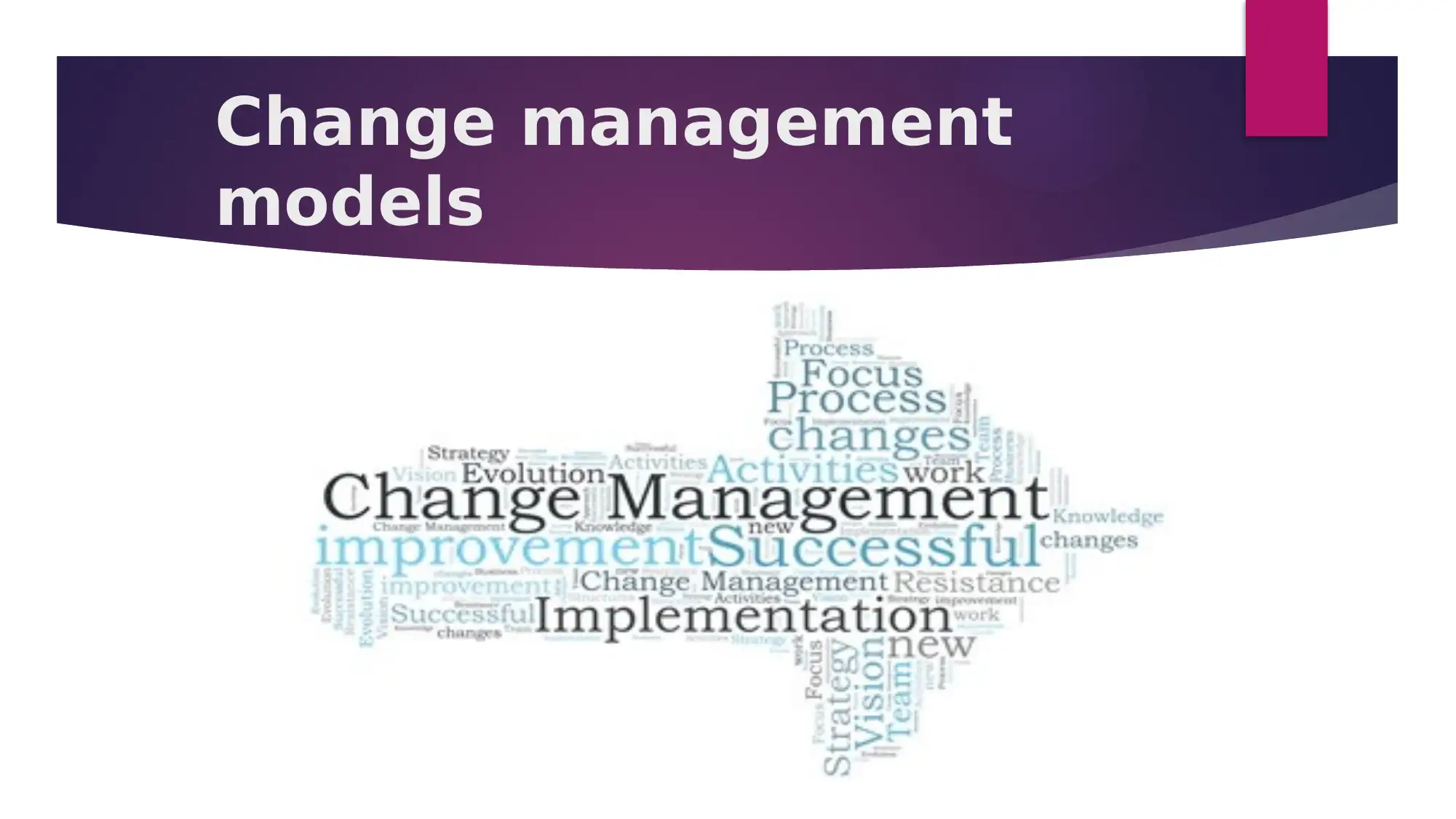
Change management
models
models
Paraphrase This Document
Need a fresh take? Get an instant paraphrase of this document with our AI Paraphraser

Introduction
Change management is a process
which is considered to be highly
important for the organizations
which operate in the modern
changing environment. The
organizations which are a part of
the environment thereby need to
maintain the processes with the
help of proper change management
in order to operate in a profitable
manner Al-(Haddad & Kotnour, 2015).
Change management is a process
which is considered to be highly
important for the organizations
which operate in the modern
changing environment. The
organizations which are a part of
the environment thereby need to
maintain the processes with the
help of proper change management
in order to operate in a profitable
manner Al-(Haddad & Kotnour, 2015).
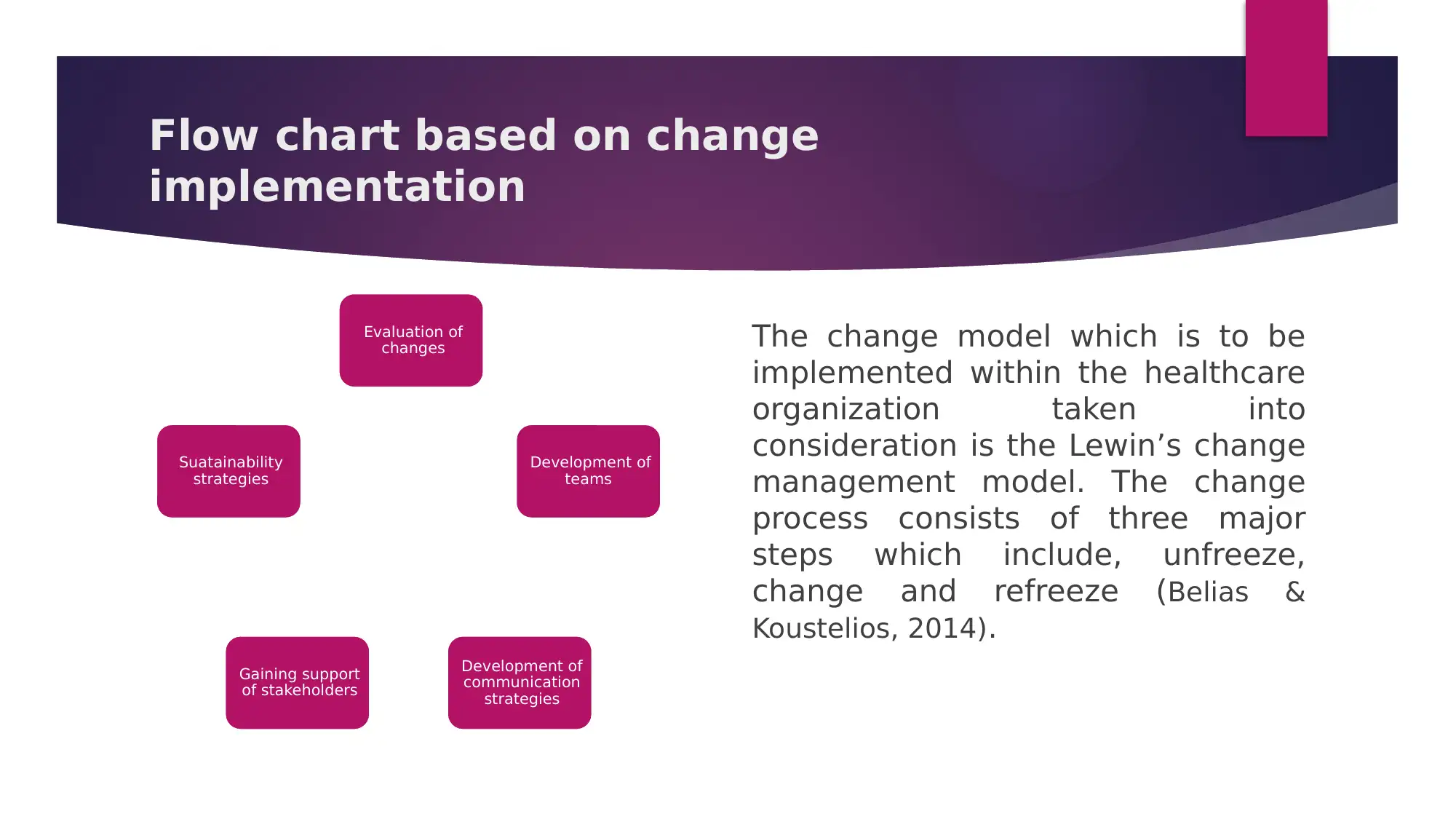
Flow chart based on change
implementation
The change model which is to be
implemented within the healthcare
organization taken into
consideration is the Lewin’s change
management model. The change
process consists of three major
steps which include, unfreeze,
change and refreeze (Belias &
Koustelios, 2014).
Evaluation of
changes
Development of
teams
Development of
communication
strategies
Gaining support
of stakeholders
Suatainability
strategies
implementation
The change model which is to be
implemented within the healthcare
organization taken into
consideration is the Lewin’s change
management model. The change
process consists of three major
steps which include, unfreeze,
change and refreeze (Belias &
Koustelios, 2014).
Evaluation of
changes
Development of
teams
Development of
communication
strategies
Gaining support
of stakeholders
Suatainability
strategies
⊘ This is a preview!⊘
Do you want full access?
Subscribe today to unlock all pages.

Trusted by 1+ million students worldwide
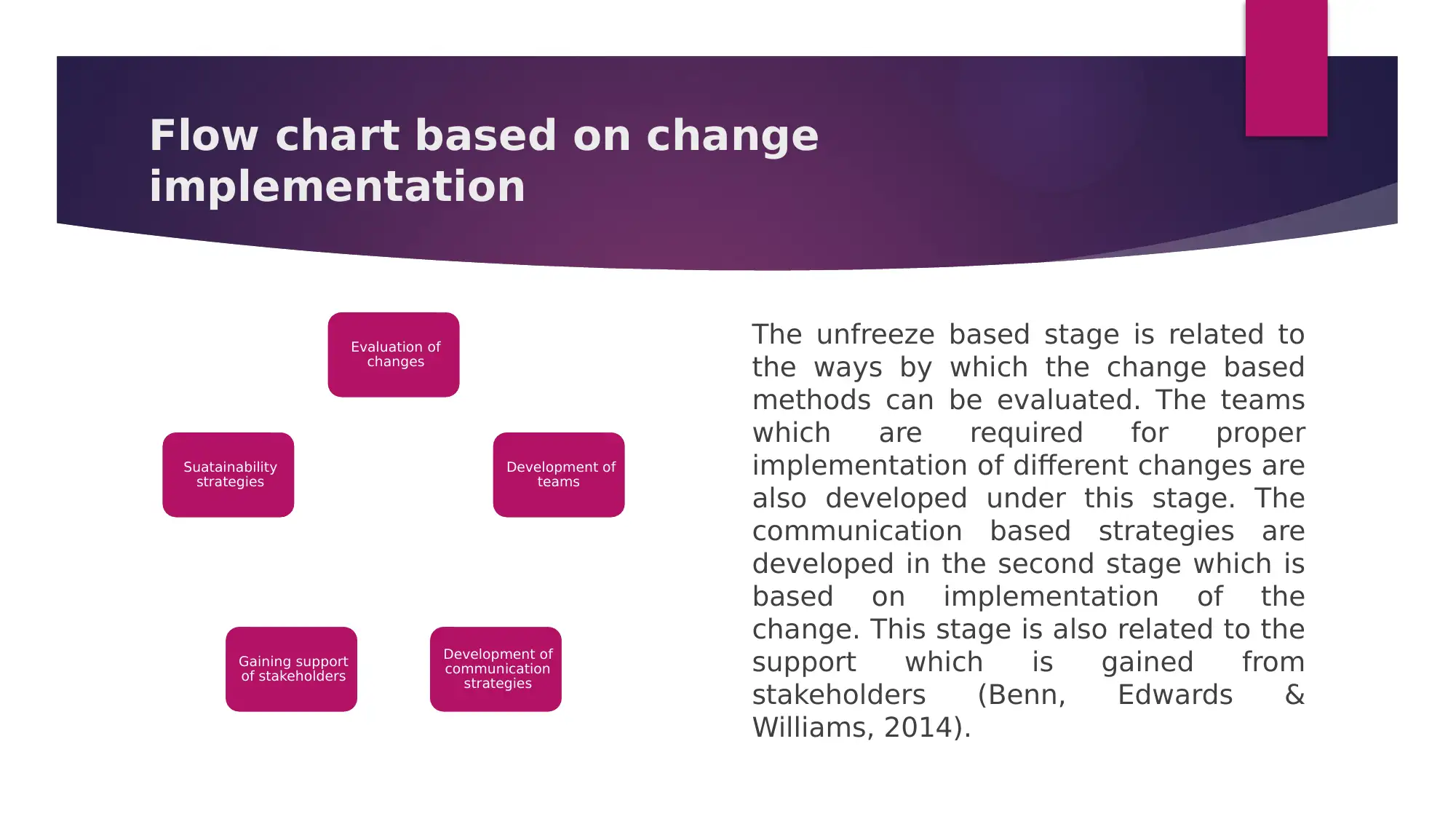
Flow chart based on change
implementation
The unfreeze based stage is related to
the ways by which the change based
methods can be evaluated. The teams
which are required for proper
implementation of different changes are
also developed under this stage. The
communication based strategies are
developed in the second stage which is
based on implementation of the
change. This stage is also related to the
support which is gained from
stakeholders (Benn, Edwards &
Williams, 2014).
Evaluation of
changes
Development of
teams
Development of
communication
strategies
Gaining support
of stakeholders
Suatainability
strategies
implementation
The unfreeze based stage is related to
the ways by which the change based
methods can be evaluated. The teams
which are required for proper
implementation of different changes are
also developed under this stage. The
communication based strategies are
developed in the second stage which is
based on implementation of the
change. This stage is also related to the
support which is gained from
stakeholders (Benn, Edwards &
Williams, 2014).
Evaluation of
changes
Development of
teams
Development of
communication
strategies
Gaining support
of stakeholders
Suatainability
strategies
Paraphrase This Document
Need a fresh take? Get an instant paraphrase of this document with our AI Paraphraser
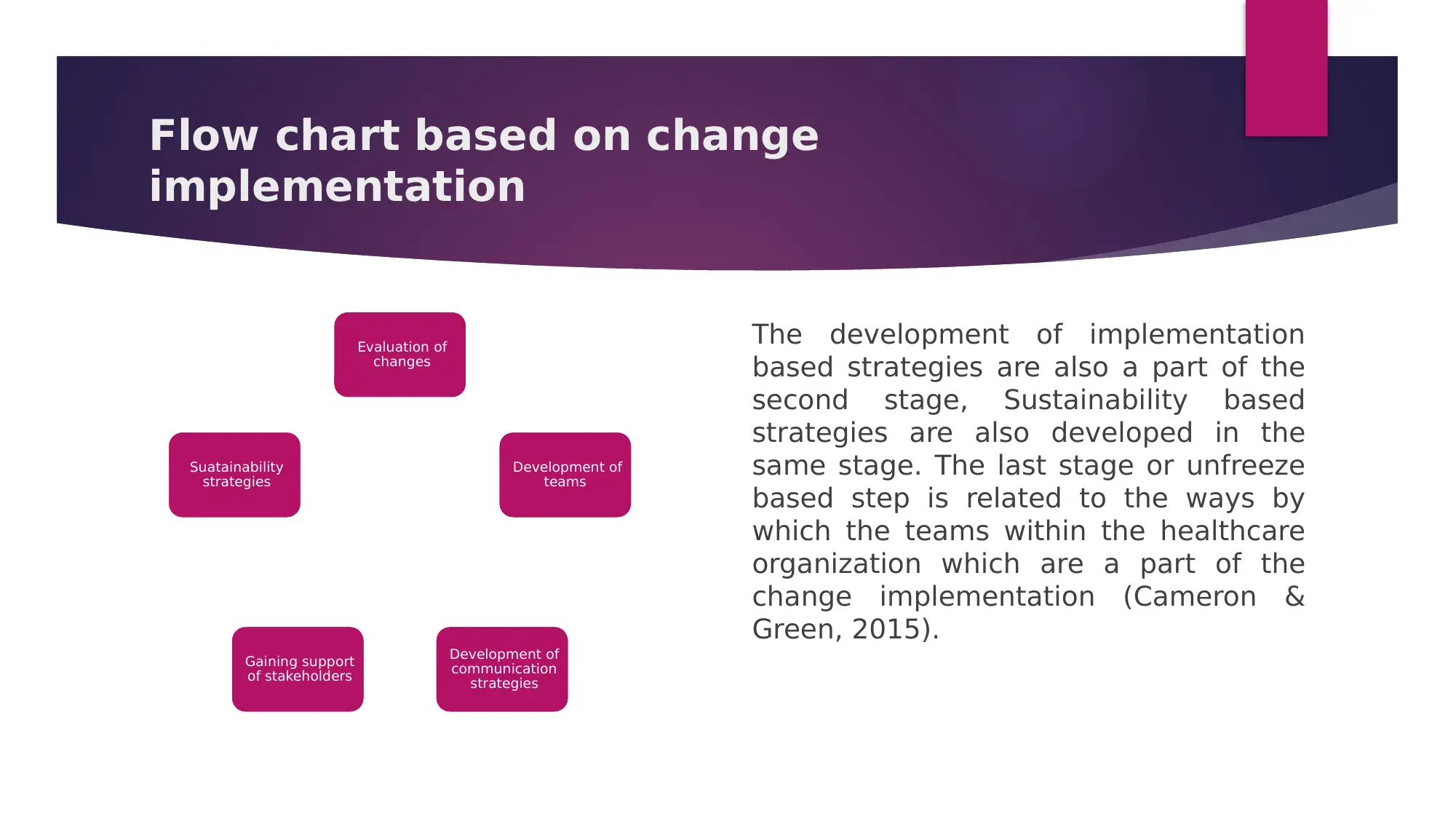
Flow chart based on change
implementation
The development of implementation
based strategies are also a part of the
second stage, Sustainability based
strategies are also developed in the
same stage. The last stage or unfreeze
based step is related to the ways by
which the teams within the healthcare
organization which are a part of the
change implementation (Cameron &
Green, 2015).
Evaluation of
changes
Development of
teams
Development of
communication
strategies
Gaining support
of stakeholders
Suatainability
strategies
implementation
The development of implementation
based strategies are also a part of the
second stage, Sustainability based
strategies are also developed in the
same stage. The last stage or unfreeze
based step is related to the ways by
which the teams within the healthcare
organization which are a part of the
change implementation (Cameron &
Green, 2015).
Evaluation of
changes
Development of
teams
Development of
communication
strategies
Gaining support
of stakeholders
Suatainability
strategies
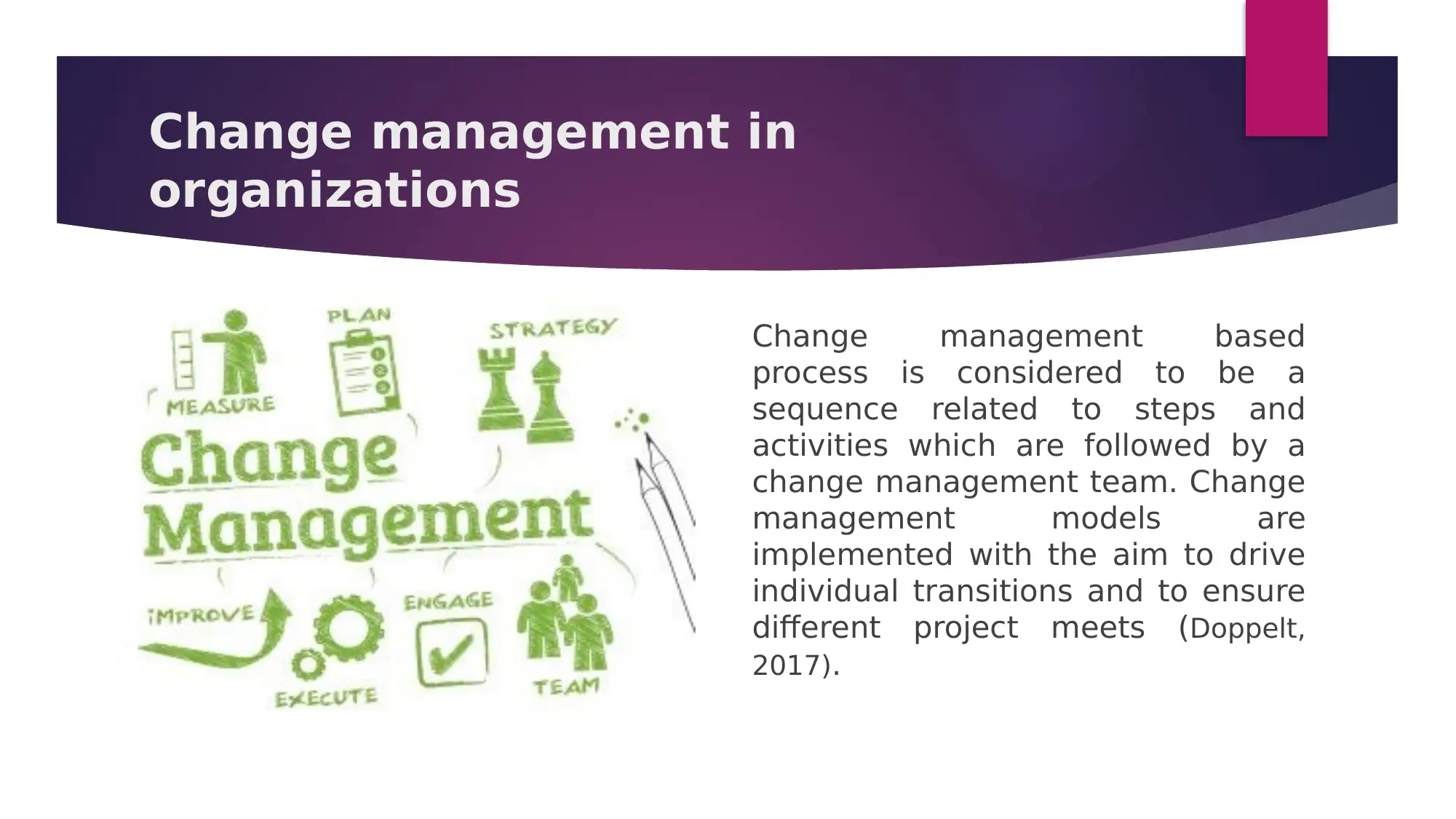
Change management in
organizations
Change management based
process is considered to be a
sequence related to steps and
activities which are followed by a
change management team. Change
management models are
implemented with the aim to drive
individual transitions and to ensure
different project meets (Doppelt,
2017).
organizations
Change management based
process is considered to be a
sequence related to steps and
activities which are followed by a
change management team. Change
management models are
implemented with the aim to drive
individual transitions and to ensure
different project meets (Doppelt,
2017).
⊘ This is a preview!⊘
Do you want full access?
Subscribe today to unlock all pages.

Trusted by 1+ million students worldwide
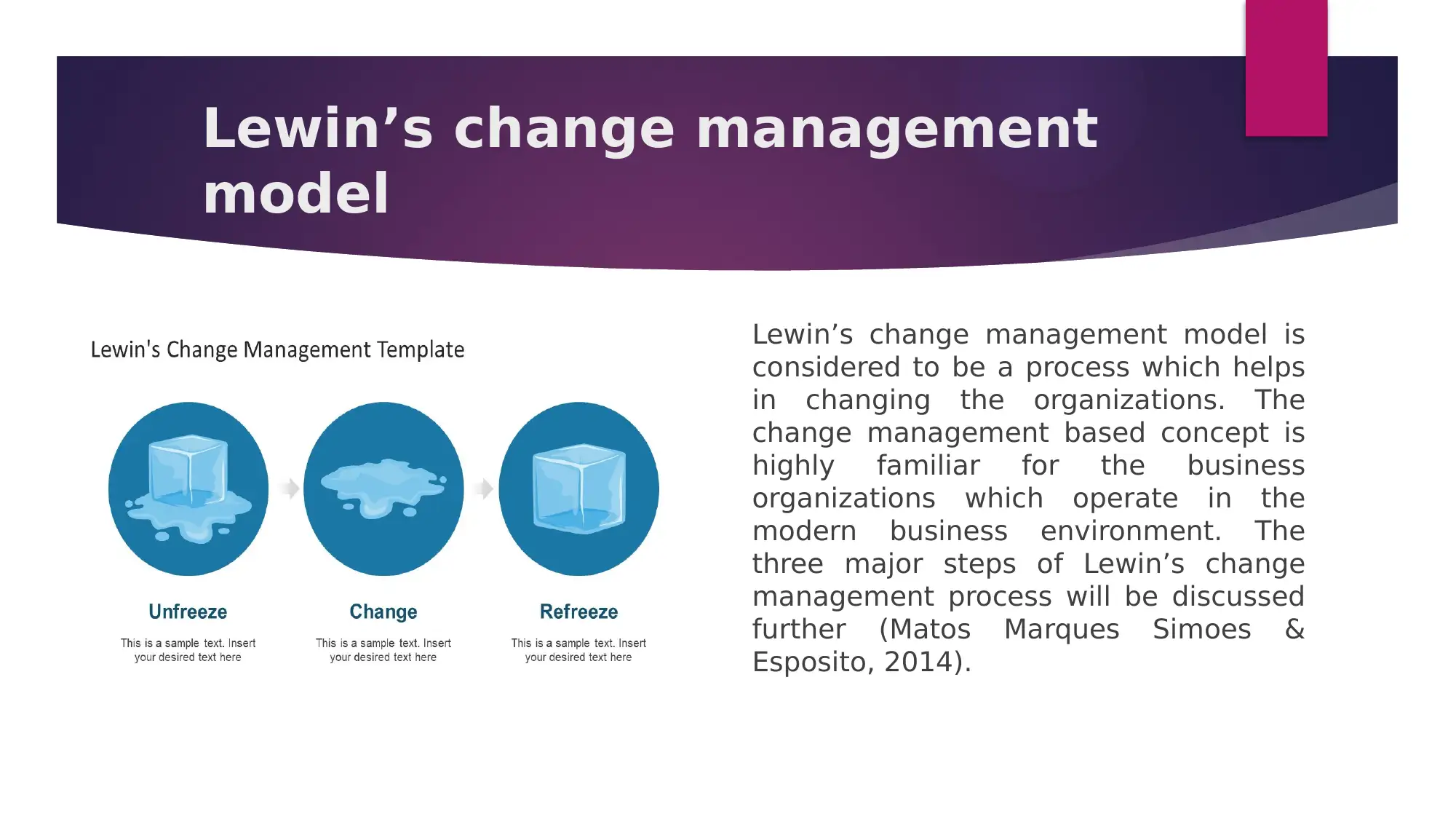
Lewin’s change management
model
Lewin’s change management model is
considered to be a process which helps
in changing the organizations. The
change management based concept is
highly familiar for the business
organizations which operate in the
modern business environment. The
three major steps of Lewin’s change
management process will be discussed
further (Matos Marques Simoes &
Esposito, 2014).
model
Lewin’s change management model is
considered to be a process which helps
in changing the organizations. The
change management based concept is
highly familiar for the business
organizations which operate in the
modern business environment. The
three major steps of Lewin’s change
management process will be discussed
further (Matos Marques Simoes &
Esposito, 2014).
Paraphrase This Document
Need a fresh take? Get an instant paraphrase of this document with our AI Paraphraser

Lewin’s change management
model
The first stage of Lewin’s change
management model is unfreeze. This
stage is mainly based on the ways by
which an organization is prepared
before change is actually implemented.
The process of effective change
management needs to be based on the
core operations. Preparing different
departments of the organization for
effective change management is a part
of this step of the process (Wagner,
2016).
model
The first stage of Lewin’s change
management model is unfreeze. This
stage is mainly based on the ways by
which an organization is prepared
before change is actually implemented.
The process of effective change
management needs to be based on the
core operations. Preparing different
departments of the organization for
effective change management is a part
of this step of the process (Wagner,
2016).
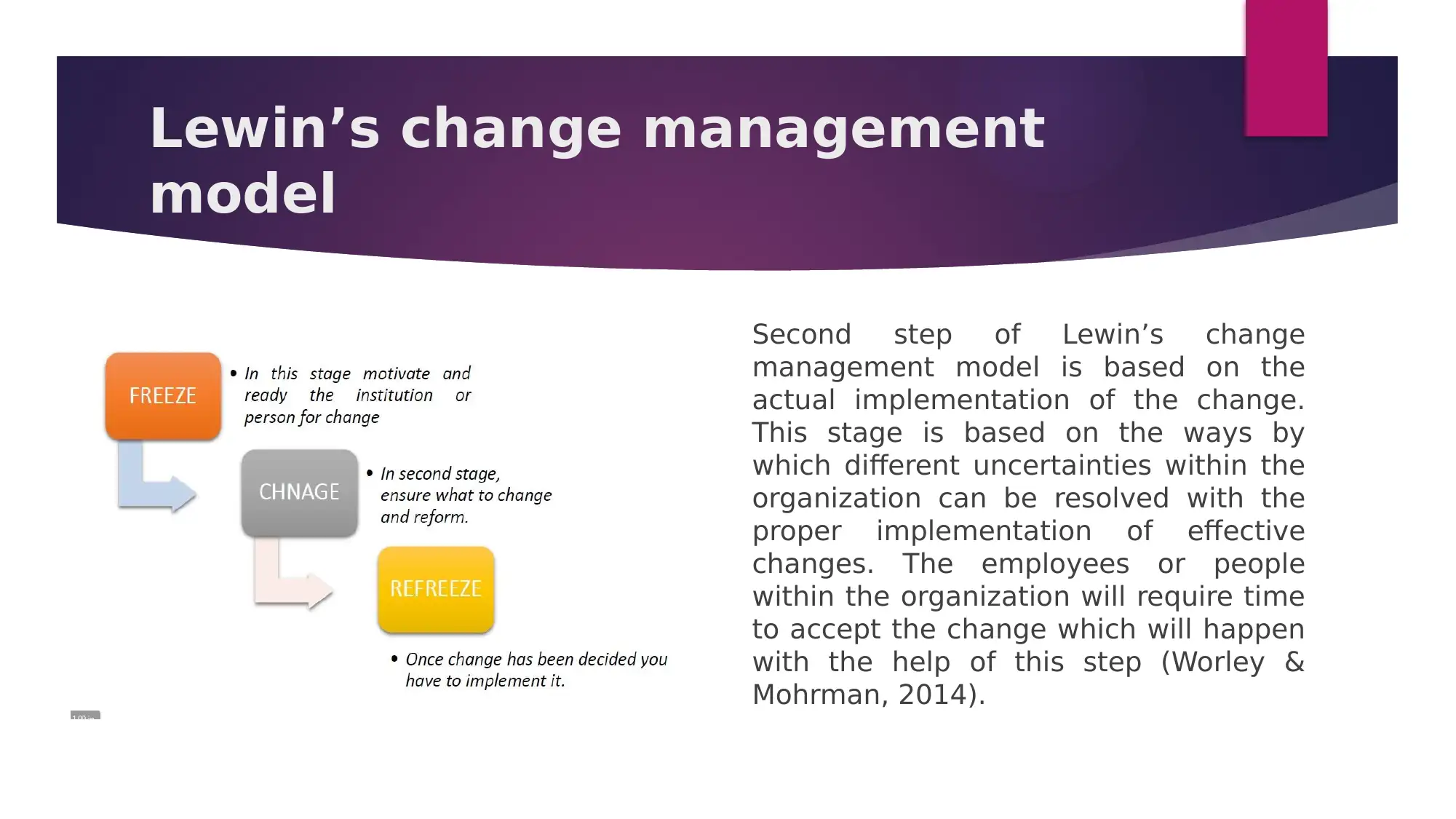
Lewin’s change management
model
Second step of Lewin’s change
management model is based on the
actual implementation of the change.
This stage is based on the ways by
which different uncertainties within the
organization can be resolved with the
proper implementation of effective
changes. The employees or people
within the organization will require time
to accept the change which will happen
with the help of this step (Worley &
Mohrman, 2014).
model
Second step of Lewin’s change
management model is based on the
actual implementation of the change.
This stage is based on the ways by
which different uncertainties within the
organization can be resolved with the
proper implementation of effective
changes. The employees or people
within the organization will require time
to accept the change which will happen
with the help of this step (Worley &
Mohrman, 2014).
⊘ This is a preview!⊘
Do you want full access?
Subscribe today to unlock all pages.

Trusted by 1+ million students worldwide

Lewin’s change management
model
The third and final stage of this process
is based on the ways by which the
people react after they have been able
to embrace the changes. The refreeze
stage is based on the stability of the
organizational chart after changes have
been implemented. The new business
operations can be started effectively
after the changes have been
implemented (Worley & Mohrman,
2014).
model
The third and final stage of this process
is based on the ways by which the
people react after they have been able
to embrace the changes. The refreeze
stage is based on the stability of the
organizational chart after changes have
been implemented. The new business
operations can be started effectively
after the changes have been
implemented (Worley & Mohrman,
2014).
Paraphrase This Document
Need a fresh take? Get an instant paraphrase of this document with our AI Paraphraser

Kotter's change management model
Kotter’s eight-step change management model
has been developed with the help of analysis of
more than 100 companies. The eight steps are
mainly based on the ways by which an
organization and its management is able to
implement different changes in an effective
manner with the help of eight different steps.
This model of change management is
considered to be useful for the proper
implementation of transformational change.
The success of organizational change
implementation is also considered to be a
major factor which affects the organizational
operations in a huge manner (Wagner, 2016).
Kotter’s eight-step change management model
has been developed with the help of analysis of
more than 100 companies. The eight steps are
mainly based on the ways by which an
organization and its management is able to
implement different changes in an effective
manner with the help of eight different steps.
This model of change management is
considered to be useful for the proper
implementation of transformational change.
The success of organizational change
implementation is also considered to be a
major factor which affects the organizational
operations in a huge manner (Wagner, 2016).

Kotter's change management model
First step of the process is based on creating
a sense related to urgency. Second step of
the process is based on the development of
the guiding team. Third step is related to the
development of an effective vision. Fourth
step is related to communication which is
made for buy-in. Fifth step is related to the
empowerment of actions. The development
of short-term based wins is the sixth step.
Seventh step is based on achievement of the
continuous. The eight and last step is based
on proper implementation of the change
(Matos Marques Simoes & Esposito, 2014).
First step of the process is based on creating
a sense related to urgency. Second step of
the process is based on the development of
the guiding team. Third step is related to the
development of an effective vision. Fourth
step is related to communication which is
made for buy-in. Fifth step is related to the
empowerment of actions. The development
of short-term based wins is the sixth step.
Seventh step is based on achievement of the
continuous. The eight and last step is based
on proper implementation of the change
(Matos Marques Simoes & Esposito, 2014).
⊘ This is a preview!⊘
Do you want full access?
Subscribe today to unlock all pages.

Trusted by 1+ million students worldwide
1 out of 15
Related Documents
Your All-in-One AI-Powered Toolkit for Academic Success.
+13062052269
info@desklib.com
Available 24*7 on WhatsApp / Email
![[object Object]](/_next/static/media/star-bottom.7253800d.svg)
Unlock your academic potential
Copyright © 2020–2025 A2Z Services. All Rights Reserved. Developed and managed by ZUCOL.





